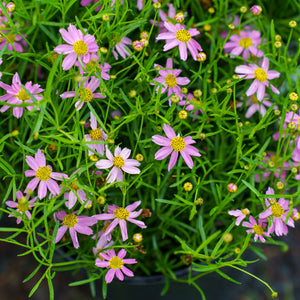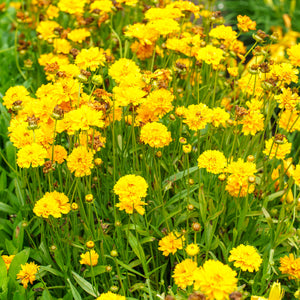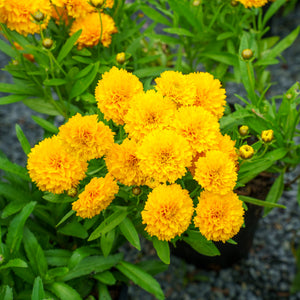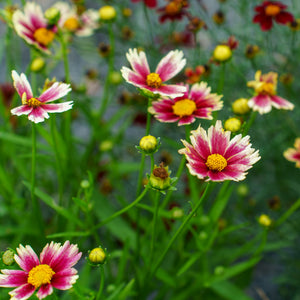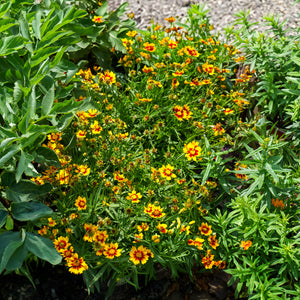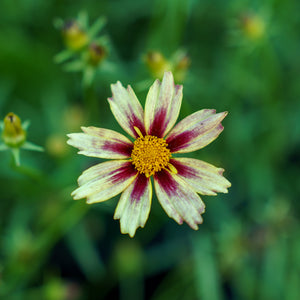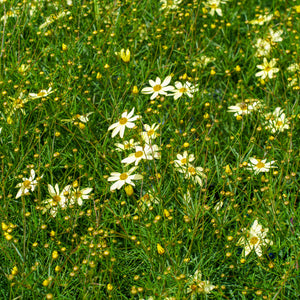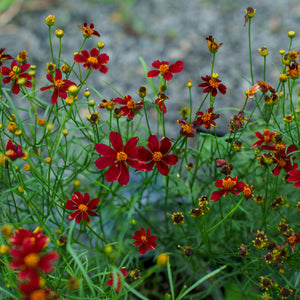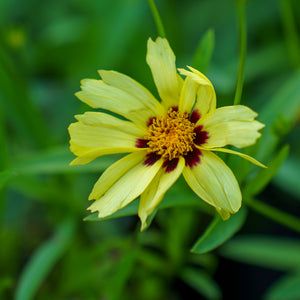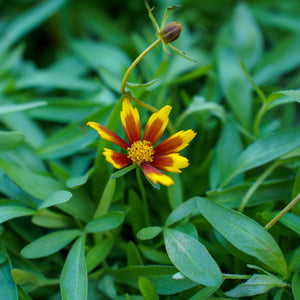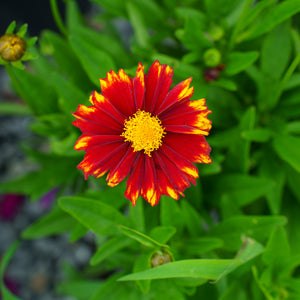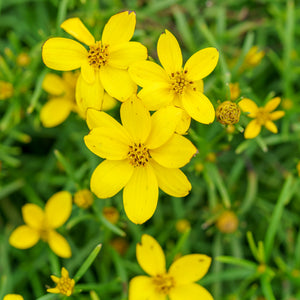The Coreopsis Guide
Coreopsis, with its sunny yellow blooms and delicate foliage, brings a cheerful and radiant touch to any garden landscape. Known for its prolific flowering and long-lasting beauty, Coreopsis is perfect for adding vibrant color to borders, beds, and containers, making it a versatile choice for various outdoor spaces. Its daisy-like flowers and easy-care nature make it a favorite among gardeners of all levels. Whether you're seeking bright yellows, rich oranges, or delicate pinks, Coreopsis offers a spectrum of colors to suit your garden style. With minimal maintenance requirements and adaptability to different soil types and sunlight conditions, Coreopsis is a hassle-free addition to any garden. Explore our Coreopsis Guide to learn more about cultivating and caring for these delightful perennials, and discover how to incorporate them into your garden for lasting beauty and enjoyment.
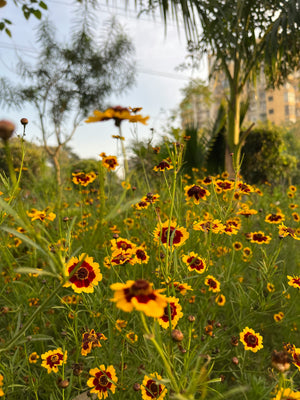
About
Coreopsis, also known by its common name tickseed, is part of the Asteraceae family, encompassing a diverse group of perennial and annual herbs cherished for their bright and cheerful blooms. Native to North and South America, these captivating plants are characterized by their daisy-like flowers, which come in a range of colors from sunny yellows and vibrant oranges to delicate pinks and whites. Coreopsis plants are commonly found in prairies, meadows, and gardens, where they play a crucial role in supporting local ecosystems by attracting pollinators like bees, butterflies, and other beneficial insects with their nectar-rich flowers.
Coreopsis's ability to thrive in various soil types, from well-drained loam to sandy soils, and its tolerance for both full sun and partial shade make it an adaptable and resilient choice for many garden settings. Their hardiness and drought tolerance also make them ideal for xeriscaping and low-maintenance gardens. In addition to their ornamental value, Coreopsis plants have been used in traditional medicine for their potential therapeutic properties.
By incorporating Coreopsis into your garden, you not only enhance its beauty but also contribute to the conservation of these remarkable plants and the biodiversity they support.
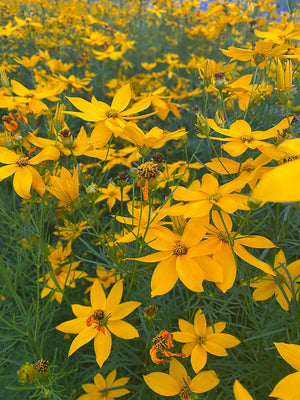
Planting
Coreopsis plants require specific planting conditions to ensure their successful establishment and flourishing growth. Here are some essential guidelines for planting and caring for Coreopsis:
Soil: Coreopsis thrives in well-drained soil with a pH level ranging from 6.0 to 7.0. Prepare the planting site by loosening the soil and incorporating organic matter to improve drainage and fertility. They can adapt to various soil types, including loam and sandy soils, but avoid heavy clay soils that may retain excessive moisture.
Sunlight: Coreopsis prefers full sun but can tolerate partial shade. Choose a location with at least six to eight hours of direct sunlight per day. In hotter climates, partial shade can provide protection from intense sunlight and heat stress.
Watering: Adequate watering is essential, especially during the initial growth stages. After planting, water the Coreopsis deeply to ensure the roots receive sufficient moisture. Provide regular irrigation, especially during dry periods, and allow the soil to dry slightly between waterings to prevent waterlogging.
Mulching: Apply a layer of organic mulch around the base of your Coreopsis plants to retain moisture, suppress weed growth, and regulate soil temperature. Use materials like wood chips, bark, or compost, ensuring they are kept a few inches away from the plant's stem to prevent moisture-related issues.
Pruning: Coreopsis generally requires minimal pruning. Remove spent flowers to encourage continuous blooming and trim back any dead or damaged foliage as needed. Prune in early spring before new growth appears to maintain a tidy appearance.
By following these planting and care instructions, you can ensure the successful establishment and thriving growth of your Coreopsis plants. With proper attention, your Coreopsis will bring beauty and color to your garden for years to come.
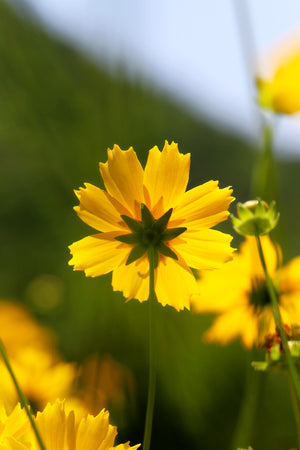
Care
Coreopsis plants require specific care to ensure their optimal growth and health. Here are some general guidelines for the care of Coreopsis:
Watering: During the growing season, provide regular watering to your Coreopsis plants. Aim to keep the soil consistently moist but not waterlogged. Water deeply at the base of the plant, rather than overhead, to prevent fungal diseases. Adjust watering frequency based on rainfall and weather conditions.
Pruning: Coreopsis plants generally require minimal pruning. Deadhead spent blooms to promote continuous flowering and maintain a tidy appearance. Remove any dead or damaged foliage as needed. Prune in late winter or early spring before new growth begins.
Fertilizing: Fertilizing can help boost the growth and blooming of Coreopsis plants. Apply a balanced, water-soluble fertilizer once or twice during the growing season, following the recommended dosage on the product label. Avoid over-fertilizing, as this can lead to excessive foliage growth at the expense of flowers.
Soil and Sunlight: Coreopsis plants thrive in well-drained soil with a pH level ranging from 6.0 to 7.0. They prefer full sun but can tolerate partial shade. Provide at least six to eight hours of direct sunlight per day for optimal blooming. Amend heavy clay soils with organic matter to improve drainage.
Mulching: Apply a layer of organic mulch around the base of your Coreopsis plants to retain moisture, suppress weed growth, and regulate soil temperature. Use materials like wood chips, bark, or compost, ensuring they don't touch the plant stems directly.
Pests and Diseases: Coreopsis plants are relatively resistant to pests and diseases. However, keep an eye out for common issues such as aphids or powdery mildew. Inspect your plants regularly and treat any infestations promptly with insecticidal soap or neem oil.
By following these basic care guidelines, your Coreopsis plants will thrive and bring beauty to your garden for years to come.
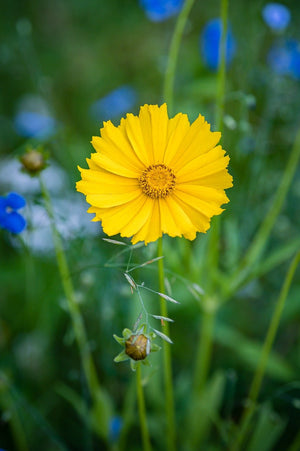
How To Use
Coreopsis plants offer versatility and can be utilized in various ways to enhance your landscape. Here are some recommendations based on their characteristics:
Colorful Borders: Coreopsis plants are perfect for creating vibrant borders in your garden. Plant them in clusters along pathways or around garden beds to add pops of cheerful color and texture. Mix different Coreopsis varieties to create dynamic combinations that bloom throughout the season.
Pollinator Gardens: Due to their nectar-rich flowers, Coreopsis attracts pollinators like bees, butterflies, and other beneficial insects, making them ideal for pollinator gardens. Plant them alongside other pollinator-friendly plants to create a thriving ecosystem that supports local wildlife.
Cut Flower Arrangements: Coreopsis blooms make stunning additions to cut flower arrangements. Harvest the flowers when they are fully open and use them in bouquets, centerpieces, or floral displays to bring the beauty of the garden indoors.
Wildflower Gardens: Coreopsis's natural, carefree appearance makes them well-suited for wildflower gardens or meadows. Their ability to thrive in various soil types and their spreading growth habit make them excellent candidates for naturalistic plantings.
Container Gardening: Coreopsis is well-suited for container gardening, making it a versatile choice for patios, balconies, or small gardens. Plant them in pots or containers and place them in sunny spots to enjoy their blooms up close.
Erosion Control: With their deep root systems, Coreopsis can help prevent soil erosion. Plant them on slopes or in areas prone to erosion to stabilize the soil and add visual interest.
Seasonal Displays: Use Coreopsis in seasonal displays to bring bright color to your garden from summer through fall. Their long-lasting blooms and resilience make them a reliable choice for extended seasonal interest.
When incorporating Coreopsis into your landscape, consider their growth habits, sunlight requirements, and soil preferences. By choosing the right placement and utilizing their versatile nature, Coreopsis plants can enhance the beauty and functionality of your outdoor space.
Conclusion
Coreopsis plants are a radiant and versatile addition to any garden landscape. With their sunny yellow blooms and delicate foliage, these cheerful flowers bring a burst of color and joy to your outdoor space. Their vibrant blooms, ease of care, and adaptability make them a favorite among gardeners of all levels. By adhering to proper planting and maintenance techniques, you can fully harness the potential of Coreopsis to elevate your garden and make a lasting impact.
Whether you seek colorful borders, pollinator-friendly gardens, or stunning cut flower arrangements, Coreopsis plants can fulfill a variety of roles in your landscape design. Plant them individually to highlight their unique colors and textures, or cluster them together for a striking visual display. Coreopsis's resilience and adaptability also make them ideal for container gardening, wildflower gardens, and erosion control.
Beyond their ornamental value, Coreopsis plants attract beneficial pollinators and contribute to the biodiversity of your garden ecosystem. With their enduring beauty, versatility, and ecological significance, Coreopsis plants bring delight and natural allure to your outdoor environment, enriching your gardening experience and enhancing the overall beauty of your landscape.

